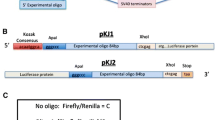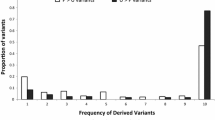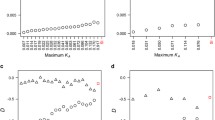Abstract
The patterns and processes of molecular evolution may differ between the X chromosome and the autosomes in Drosophila melanogaster. This may in part be due to differences in the effective population size between the two chromosome sets and in part to the hemizygosity of the X chromosome in Drosophila males. These and other factors may lead to differences both in the gene complements of the X and the autosomes and in the properties of the genes residing on those chromosomes. Here we show that codon bias and recombination rate are correlated strongly and negatively on the X chromosome, and that this correlation cannot be explained by indirect relationships with other known determinants of codon bias. This is in dramatic contrast to the weak positive correlation found on the autosomes. We explored possible explanations for these patterns, which required a comprehensive analysis of the relationships among multiple genetic properties such as protein length and expression level. This analysis highlights conserved features of coding sequence evolution on the X and the autosomes and illuminates interesting differences between these two chromosome sets.


Similar content being viewed by others
References
Akashi H (1994) Synonymous codon usage in Drosophila melanogaster: Natural selection and translational accuracy. Genetics 136:927–935
Akashi H (1995) Inferring weak selection from patterns of polymorphism and divergence at “silent” sites in Drosophila DNA. Genetics 139:1067–1076
Akashi H (1996) Molecular evolution between Drosophila melanogaster and D. simulans: reduced codon bias. Faster rates of amino acid substitution, and larger proteins in D. melanogaster. Genetics 144:1297–1307
Akashi H, Eyre-Walker A (1998) Translational selection and molecular evolution. Curr Opin Genet Dev 8:688–693
Akashi H, Kliman RM, Eyre-Walker A (1998) Mutation pressure, natural selection, and the evolution of base composition in Drosophila. Genetica (Dordrecht) 102-103:49–60
Aquadro CF (1997) Insights into the evolutionary process from patterns of DNA sequence variability. Curr Opin Genet Dev 7:835–840
Begun DJ, Aquadro CF (1992) Levels of naturally occurring DNA polymorphism correlate with recombination rates in Drosophila melanogaster. Nature (London) 356:519–520
Betancourt AJ, Presgraves DC (2002) Linkage limits the power of natural selection in Drosophila. Proc Natl Acad Sci USA 99:13616–13620
Betran E, Thornton K, Long M (2002) Retroposed new genes out of the X in Drosophila. Genome Res 12:1854–1859
Birdsell JA (2002) Integrating genomics, bioinformatics, and classical genetics to study the effects of recombination on genome evolution. Mol Biol Evol 19:1181–1197
Bridges CB (1935) Salivary chromosome maps with a key to the banding of the chromosomes of Drosophila melanogaster. J Hered 26:60–64
Bulmer M (1988) Are codon usage patterns in unicellular organisms determined by selection mutation balance? J Evol Biol 1:15–26
Bulmer M (1991) The selection-mutation-drift theory of synonymous codon usage. Genetics 129:897–908
Caballero A (1995) On the effective size of populations with separate sexes, with particular reference to sex-linked genes. Genetics 139:1007–1011
Carvalho AB, Clark AG (1999) Intron size and natural selection. Nature (London) 401:344
Charlesworth B (1991) The evolution of sex chromosomes. Science (Washington DC) 251:1030–1033
Charlesworth B, Coyne JA, Barton NH (1987) The relative rates of evolution of sex chromosomes and autosomes. Am Natural 130:113–146
Comeron JM, Kreitman M (1998) The correlation between synonymous and nonsynonymous substitutions in Drosophila: Mutation, selection or relaxed constraints? Genetics 150:767–775
Comeron JM, Kreitman M (2000) The correlation between intron length and recombination in Drosophila: Dynamic equilibrium between mutational and selective forces. Genetics 156:1175–1190
Comeron JM, Kreitman M (2002) Population, evolutionary and genomic consequences of interference selection. Genetics 161:389–410
Comeron JM, Kreitman M, Aguade M (1999) Natural selection on synonymous sites is correlated with gene length and recombination in Drosophila. Genetics 151:239–249
Conery JS, Lynch M (2001) Nucleotide substitutions and the evolution of duplicate genes. Pacific Symposium on Biocomputing, pp 167–178
Duret L, Mouchiroud D (1999) Expression pattern and, surprisingly, gene length shape codon usage in Caenorhabditis, Drosophila, and Arabidopsis. Proc Natl Acad Sci USA 96:4482–4487
Duret L, Mouchiroud D (2000) Determinants of substitution rates in mammalian genes: Expression pattern affects selection intensity but not mutation rate. Mol Biol Evol 17:68–74
Emerson JJ, Kaessmann H, Betran E, Long M (2004) Extensive gene traffic on the mammalian X chromosome. Science (Washington DC) 303:537–540
Eyre-Walker A, (1996) Synonymous codon bias is related to gene length in Escherichia coli: Selection for translational accuracy? Mol Biol Evol 13:864–872
Hey J, Kliman RM (2002) Interactions between natural selection, recombination and gene density in the genes of Drosophila. Genetics 160:595–608
Hill WG, Robertson A (1966) The effect of linkage on limits to artificial selection. Genet Res 8:269–294
Kim Y (2004) Effect of strong directional selection on weakly selected mutations at linked sites: Implication for synonymous codon usage. Mol Biol Evol 21:286–294
Kindahl EC (1994) Recombination and DNA polymorphism on the third chromosome of Drosophila melanogaster. Cornell University. Ithaca, NY
Kliman RM, Hey J (1993) Reduced natural selection associated with low recombination in Drosophila melanogaster. Mol Biol Evol 10:1239–1258
Kliman RM, Hey J (2003) Hill-Robertson interference in Drosophila melanogaster: Reply to Marais, Mouchiroud and Duret. Genet Res 81:89–90
Krylov DM, Wolf YI, Rogozin IB, Koonin EV (2003) Gene loss, protein sequence divergence, gene dispensability, expression level, and interactivity are correlated in eukaryotic evolution. Genome Res 13:2229–2235
Langley CH, Lazzaro BP, Phillips W, Heikkinen E, Braverman JM (2000) Linkage disequilibria and the site frequency spectra in the su(s) and su(wa) regions of the Drosophila melanogaster X chromosome. Genetics 156:1837–1852
Laporte V, Charlesworth B (2002) Effective population size and population subdivision in demographically structured populations. Genetics 162:501–519
Marais G, Duret L (2001) Synonymous codon usage, accuracy of translation, and gene length in Caenorhabditis elegans. J Mol Evol 52:275–280
Marais G, Mouchiroud D, Duret L (2001) Does recombination improve selection on codon usage? Lessons from nematode and fly complete genomes. Proc Natl Acad Sci USA 98:5688–5692
Marais G, Mouchiroud D, Duret L (2003) Neutral effect of recombination on base composition in Drosophila. Genet Res 81:79–87
Marin I, Siegal ML, Baker BS (2000) The evolution of dosage-compensation mechanisms. Bioessays 22:1106–1114
Pal C, Papp B, Hurst LD (2001) Highly expressed genes in yeast evolve slowly. Genetics 158:927–931
Parisi M, Nuttall R, Naiman D, Bouffard G, Malley J, Andrews J, Eastman S, Oliver B (2003) Paucity of genes on the Drosophila X chromosome showing male-biased expression. Science (Washington DC) 299:697–700
Schmid KJ, Aquadro CF (2001) The evolutionary analysis of “orphans” from the Drosophila genome identifies rapidly diverging and incorrectly annotated genes. Genetics 159:589–598
Sharp PM, Li WH (1986) An evolutionary perspective on synonymous codon usage in unicellular organisms. J Mol Evol 24:28–38
Shields DC, Sharp PM, Higgins DG, Wright F (1988) ‘Silent’ sites in Drosophila genes are not neutral: evidence of selection among synonymous codons. Mol Biol Evol 5:704–716
Singh ND, Arndt PF, Petrov DA (2005) Genomic heterogeneity of background substitutional patterns in Drosophila melanogaster. Genetics 169:709–722
Sorsa V (1988) Chromosome maps of Drosophila. CRC Press. Boca Raton, FL
Subramanian S, Kumar S (2004) Gene expression intensity shapes evolutionary rates of the proteins encoded by the vertebrate genome. Genetics 168:373–381
Takano-Shimizu T (1999) Local recombination and mutation effects on molecular evolution in Drosophila. Genetics 153:1285–1296
True JR, Mercer JM, Laurie CC (1996) Differences in crossover frequency and distribution among three sibling species of Drosophila. Genetics 142:507–523
Wright SI, Yau CBK, Looseley M, Meyers BC (2004) Effects of gene expression on molecular evolution in Arabidopsis thaliana and Arabidopsis lyrata. Mol Biol Evol 21:1719–1726
Yang Z, (1997) PAML: am program package for phylogenetic analysis by maximum likelihood. Comput Appl Biosci 13:555–556
Acknowledgments
This work was supported in part by the Stanford Genome Training Program (funded by 5 T32 HG00044 from the National Human Genome Research Institute) to N.D.S. and a Sloan Fellowship to D.A.P. Comments from two anonymous reviews, an associate editor, and the editor-in-chief considerably improved this manuscript.
Author information
Authors and Affiliations
Corresponding author
Additional information
[Reviewing editor: Dr. Richard Kliman]
Rights and permissions
About this article
Cite this article
Singh, N.D., Davis, J.C. & Petrov, D.A. Codon Bias and Noncoding GC Content Correlate Negatively with Recombination Rate on the Drosophila X Chromosome. J Mol Evol 61, 315–324 (2005). https://doi.org/10.1007/s00239-004-0287-1
Received:
Accepted:
Published:
Issue Date:
DOI: https://doi.org/10.1007/s00239-004-0287-1




